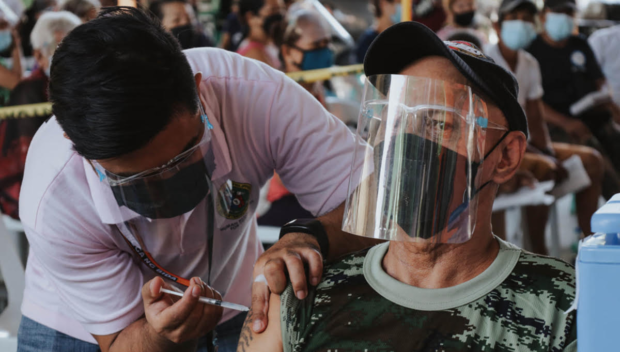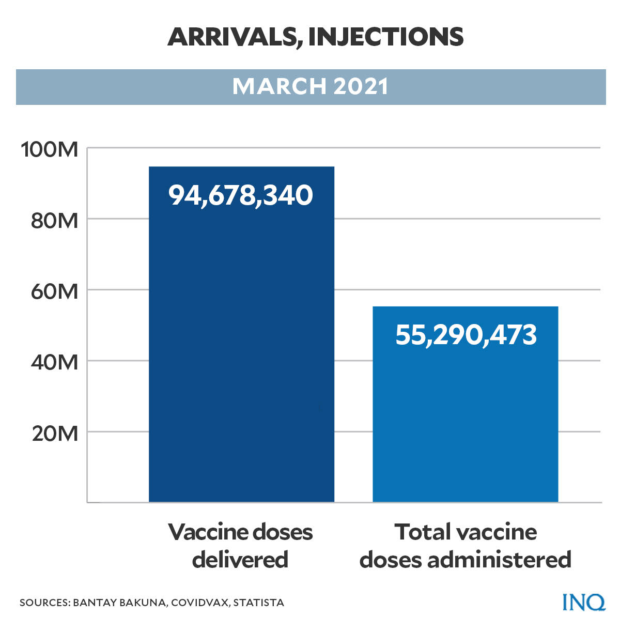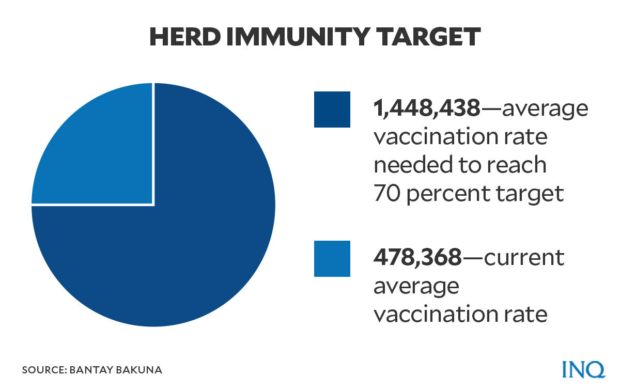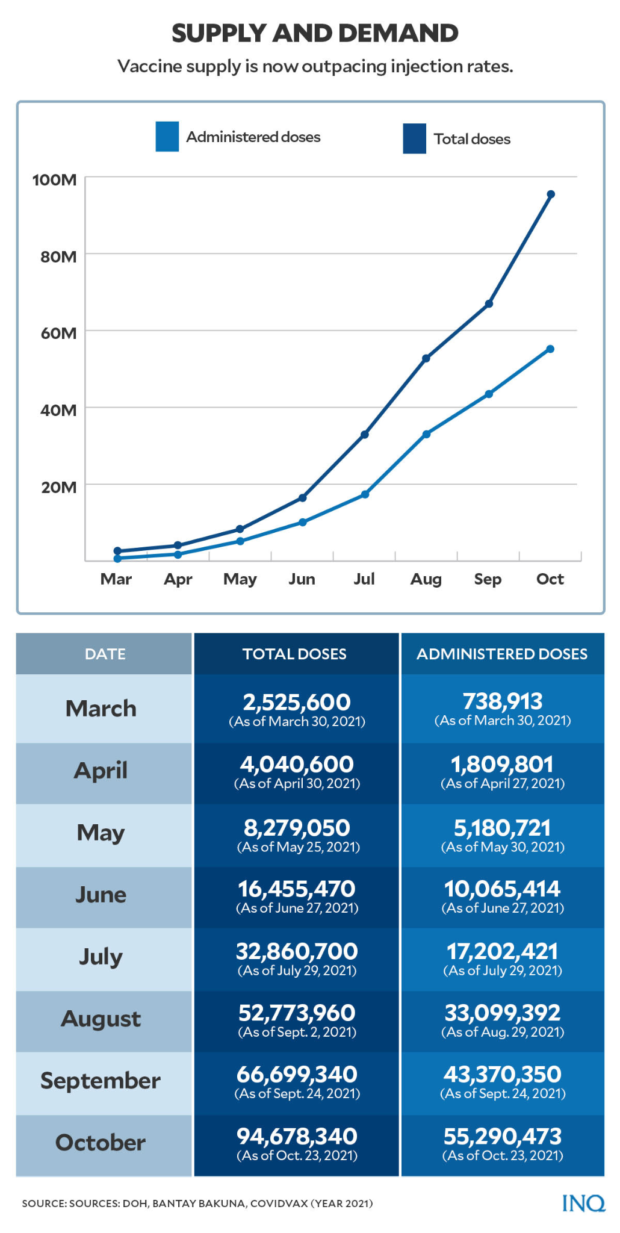PH injection rates fail to catch up with vaccine supply

FILE PHOTO: A senior citizen at Barangay Mabayuan in Olongapo City gets injected with the coronavirus vaccine through mobile clinics brought to the villages by the city government. (PHOTO FROM OLONGAPO CITY INFORMATION OFFICE)
MANILA, Philippines—The Philippines has now over 94 million doses of coronavirus vaccine—55 million already administered—but has fully vaccinated only 23.24 percent of the target population or 25.6 million Filipinos.
The Philippines has a seven-day average of 478,368 doses administered each day, less than the 523,018 doses in August. The group Bantay Bakuna estimated that to reach the target or 70 percent of the population by December, the average should be at least 1,448,438 doses a day.
Officials in charge of the vaccination rollout said ways are being drawn up to distribute vaccines as quickly as possible to local governments but because of “throughput,” injecting over one million doses a day would be close to impossible.
READ: PH COVID-19 vaccination program now faces logistical problems, says Galvez
Last Oct. 20, Carlito Galvez, chief implementer of the National Action Plan Against COVID-19, said the Philippines has over 39 million doses and officials were addressing bottlenecks in distributing vaccines to local governments.
READ: Galvez: Vaccine supply not a problem anymore
Dr. Jamie Dasmariñas, doctor representative of Bantay Bakuna, however, said that the system for a national program to protect Filipinos against COVID-19 should have been prepared ahead, especially because it was “devolved.”
Slowed down
While the “throughput” recently slowed down the distribution of vaccines, the system had been slow since March, when there were 2,525,600 doses but only 738,913 doses administered.
Last Sept. 19, Vice President Leni Robredo said the government was slow in distributing COVID-19 vaccine doses, saying that 30 million Filipinos should have been vaccinated if the government was exigent in its processes.
As of Oct. 23, 94,678,340 doses had been given to the Philippines. Bantay Bakuna said these were “enough to vaccinate 42.9 percent or about 47,300,000 Filipinos.” However, only 55,290,473 doses had been administered.
Statista, a research firm, said that as of Oct. 21, in the Philippines, 29,430,000 people had already received one dose while 25,100,000 individuals had been completely vaccinated against severe COVID complications.
Nicky Cardenas said in the digest “Harnessing Strategic Policy on COVID-19 Vaccination Rollout in the Philippines” that while the Philippines has made “gradual progress,” the distribution of vaccines had been “slow.”
Cardenas said the “focus and expand” strategy of the Inter-Agency Task Force Against Infectious and Emerging Diseases and the National Task Force Against COVID-19 had been “inefficient,” especially on the rollout of AstraZeneca.
Here’s a list of the total COVID-19 vaccine doses and how many were given out each month:
• April 2021
Total doses: 4,040,600 (As of April 30, 2021)
Administered doses: 1,809,801 (As of April 27, 2021)
• May 2021
Total doses: 8,279,050 (As of May 25, 2021)
Administered doses: 5,180,721 (As of May 30, 2021)
• June 2021
Total doses: 16,455,470 (As of June 27, 2021)
Administered doses: 10,065,414 (As of June 27, 2021)
• July 2021
Total doses: 32,860,700 (As of July 29, 2021)
Administered doses: 17,202,421 (As of July 29, 2021)
• August 2021
Total doses: 52,773,960 (As of Sept. 2, 2021)
Administered doses: 33,099,392 (As of Aug. 29, 2021)
• September 2021
Total doses: 66,699,340 (As of Sept. 24, 2021)
Administered doses: 43,370,350 (As of Sept. 24, 2021)
• October 2021
Total doses: 94,678,340 (As of Oct. 23, 2021)
Administered doses: 55,290,473 (As of Oct. 23, 2021)
Our World in Data said that as of Oct. 21, the Philippines was eighth in administering vaccines per 100 people–Singapore (169), Cambodia (159), Malaysia (149), Brunei (131), Thailand (95), Vietnam (73), Indonesia (65), Philippines (49), Myanmar (29).
Strengthen services
The government takes seven to nine days to bring vaccines to inoculation sites. Galvez said the government plans to have this “fast-tracked” to give 1,500,000 doses per day.
However, Dasmariñas told INQUIRER.net that the government should also strengthen services, especially in giving out vaccines, saying that it should hire “more health care, data, and logistics” workers.
READ: PH to get more than 100 million doses of COVID-19 vaccines by end of October
“Instead of outsourcing health care workers through private institutions, the government should increase plantilla and hire health care workers centrally through the Department of Health to help local governments,” she said.
Last May, San Miguel Corporation deployed over 100 health care workers to 11 vaccination sites to help the government in vaccine distribution, especially in Mandaluyong, Malabon, and Quezon City.
“Because of the devolved services, we’ve seen that the government highly relied on local governments. It made a ‘centralized effort’ diminish. It should be recognized that the health care system is weak,” said Dasmariñas.
She also said that while local governments have established an online registration system for vaccination schedules, the government should realize that not every one has access to this through mobile phones and internet connection.
This, she said, was one of the reasons the government should hire additional workers to reach Filipinos, especially those living in far places. “The reality is that we also have a weak technology system,” Dasmariñas said.
In its 2019 National ICT Household Survey, the Department of Information and Communications Technology said that only 17.7 percent of households have internet access.
Tripartite, excessive conditions
Last April, Sen. Leila de Lima asked the government to remove the contract asking private companies to enter into tripartite agreements with the national government and vaccine manufacturers to make the rollout of doses faster.
Republic Act 11525, or the “COVID-19 Vaccination Program Act of 2021”, states that private companies and local governments are authorized to procure vaccines which have been given Emergency Use Authorization (EUA).
The Anti-Red Tape Authority, last May, also looked into “red tapes in approving vaccination venues,” saying that “immediate action is needed if there are inefficiencies and matters to be streamlined.”
RELATED STORY: October COVID-19 jabs target reached; but less than 25% of population fully vaccinated
TSB
For more news about the novel coronavirus click here.
What you need to know about Coronavirus.
For more information on COVID-19, call the DOH Hotline: (02) 86517800 local 1149/1150.
The Inquirer Foundation supports our healthcare frontliners and is still accepting cash donations to be deposited at Banco de Oro (BDO) current account #007960018860 or donate through PayMaya using this link.


